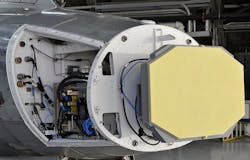Raytheon to build 19 advanced AESA radar sets for targeting and mapping on U.S. Marine Corps combat jets
PATUXENT RIVER NAS, Md. – Radar experts at Raytheon Technologies Corp. will provide the 19 AN/APG-79(V)4 active electronically scanned array (AESA) airborne radar systems to upgrade U.S. Marine Corps F/A-18C/D combat jets under terms of a $63.1 million order announced Thursday.
Officials of the U.S. Naval Air Systems Command at Patuxent River Naval Air Station, Md., are asking the Raytheon Intelligence & Space segment in El Segundo, Calif., for AN/APG-79(V)4 radar systems and software in support of radar retrofit and integration into Marine Corps F/A-18C/D Hornet carrier-based jet fighter-bombers.
The AN/APG-79(V)4 is a scaled version of the AN/APG-79 AESA radar designed originally for the U.S. Navy Boeing F/A-18E/F fighter-bomber and EA-18G Growler carrier-based electronic warfare jet. It provides aircrew situational awareness, near-instantaneous track updates, and multi-target tracking capability.
The order includes software, obsolescence management, engineering support, and technical, financial, and administrative data necessary for retrofit integration into the Marine Corps F/A-18C/D combat aircraft.
The AN/APG-79(V)4 radar provides extended detection range, simultaneous air-to-air and air-to-ground targeting capabilities, high resolution synthetic aperture radar (SAR) mapping, and high reliability.
The APG-79 radar has an open-systems architecture and rugged commercial-off-the-shelf (R-COTS) parts. Its array has solid-state transmit and receive modules for enhanced reliability, as well as an advanced receiver/exciter, ruggedized R-COTS processor, and power supplies.
The APG-79 AESA airborne radar uses transmit/receive (TR) modules populated with gallium arsenide (GaAs) monolithic microwave integrated circuits (MMICs). Presumable these are some of the electronic modules that Boeing experts will modify with updated electronics to mitigate obsolescence issues.
The radar's active electronic beam scanning helps steer the radar beam at nearly the speed of light to optimize situational awareness and air-to-air and air-to-surface capability, Raytheon officials say. The agile beam enables the multimode radar to interleave in near-real time, so that pilot and crew can use both modes simultaneously.
The first flight of a C/D Hornet fitted with this AESA radar was in January 2015, and the Marine Corps chose the AN/APG-79(V)4 radar in January 2019 to upgrade its legacy F/A-18C/D aircraft fleet. The radar enables the Hornet jet to fire several missiles at once and guide them to different targets that are widely spaced in azimuth, elevation, or range.
On this order Raytheon will do the work in Forest, Miss.; El Segundo, Calif.; Andover, Mass.; and Dallas, and should be finished by March 2023. For more information contact Raytheon Intelligence & Space online at www.rtx.com/Our-Company/Our-Businesses/RIS, or Naval Air Systems Command at www.navair.navy.mil.
About the Author
John Keller
Editor-in-Chief
John Keller is the Editor-in-Chief, Military & Aerospace Electronics Magazine--provides extensive coverage and analysis of enabling electronics and optoelectronic technologies in military, space and commercial aviation applications. John has been a member of the Military & Aerospace Electronics staff since 1989 and chief editor since 1995.
